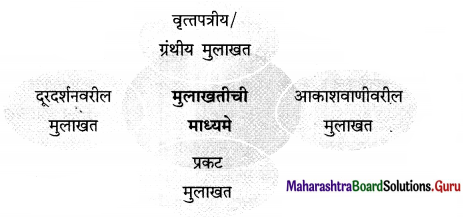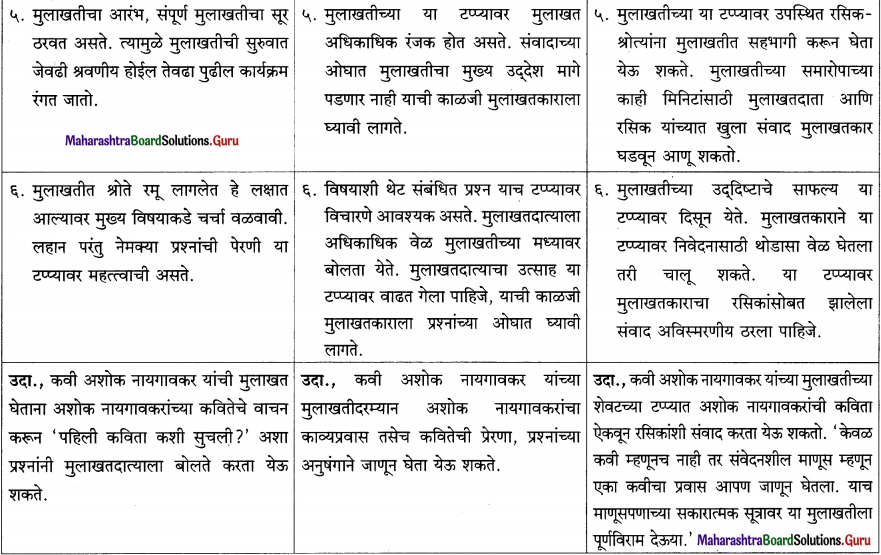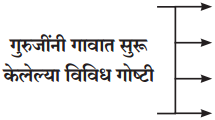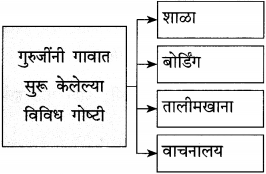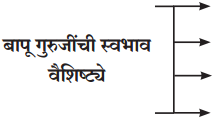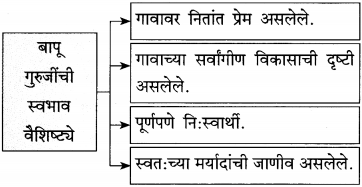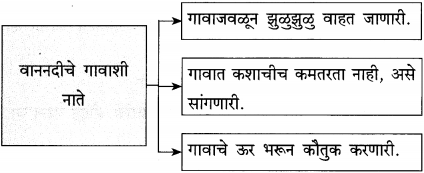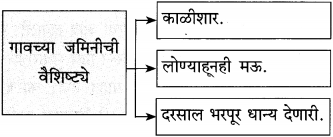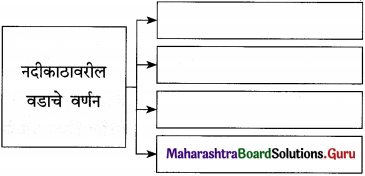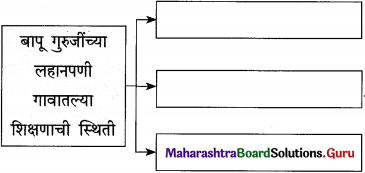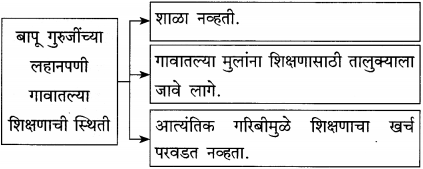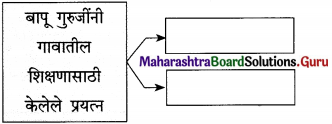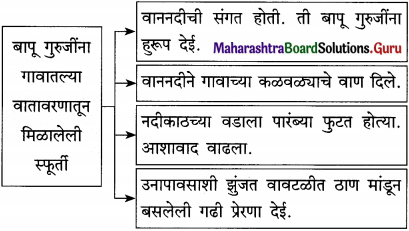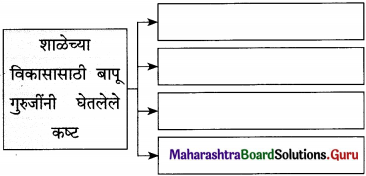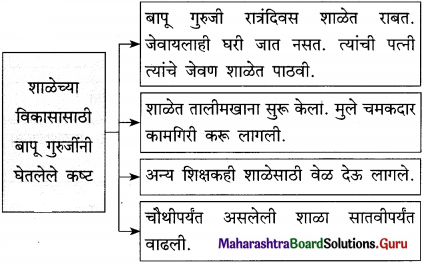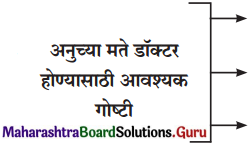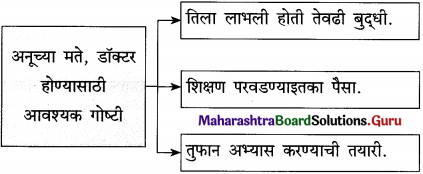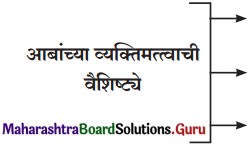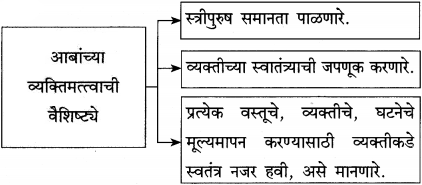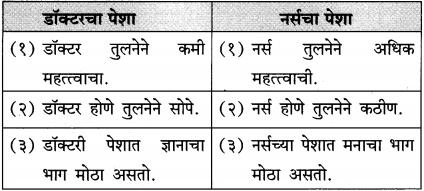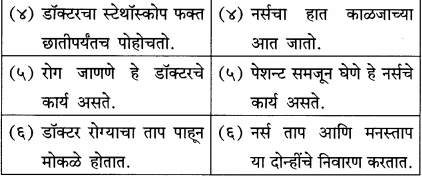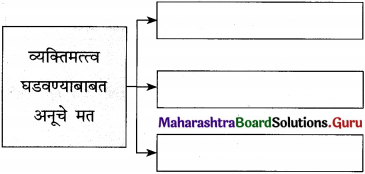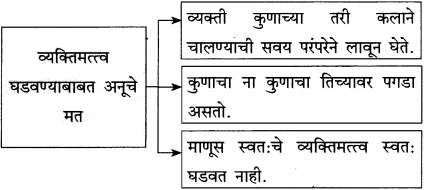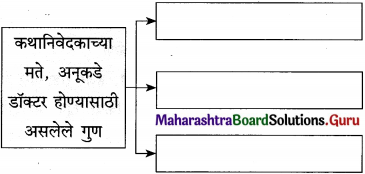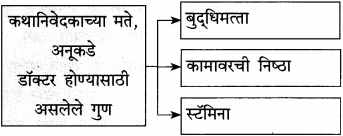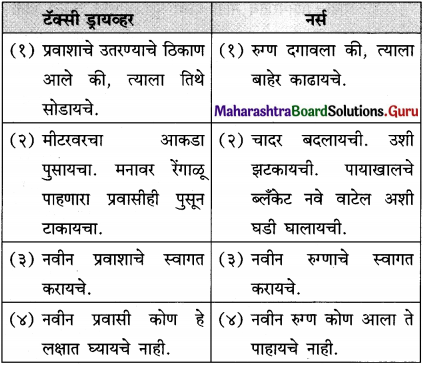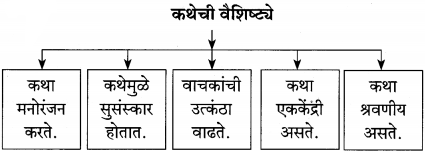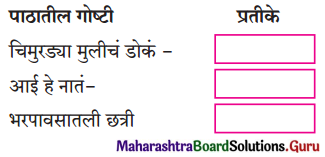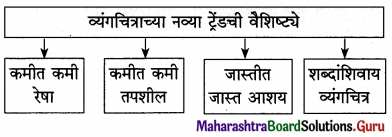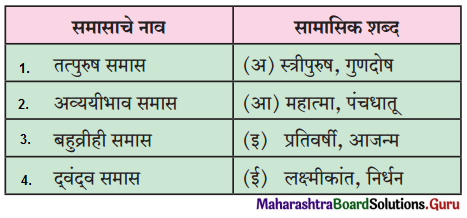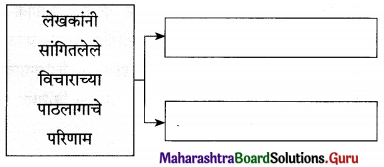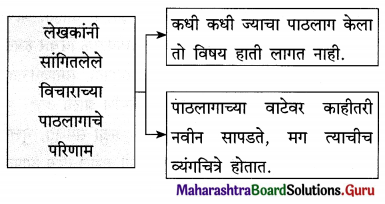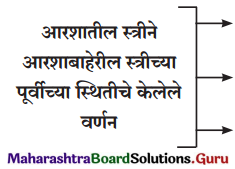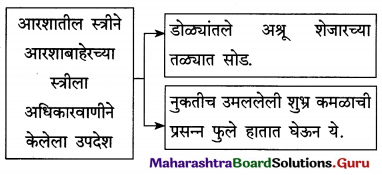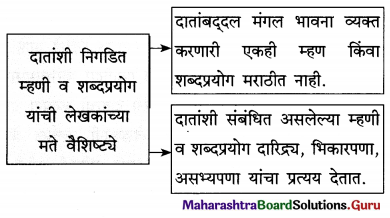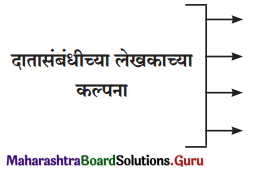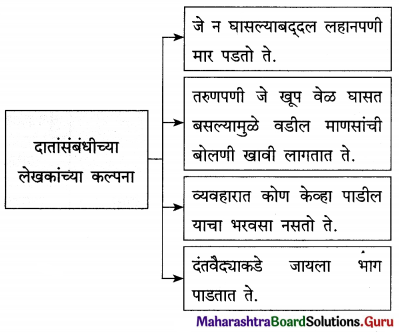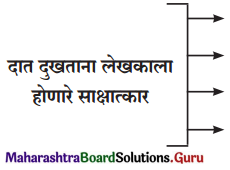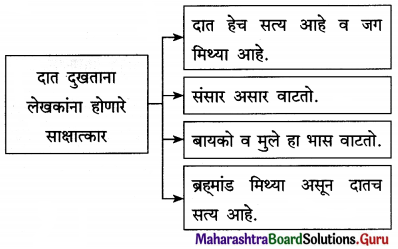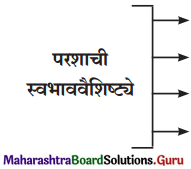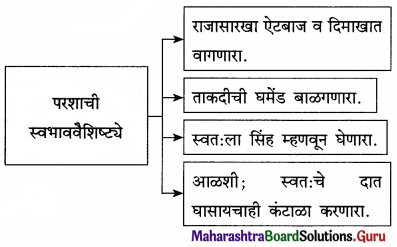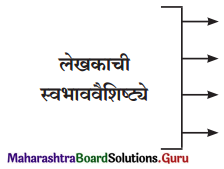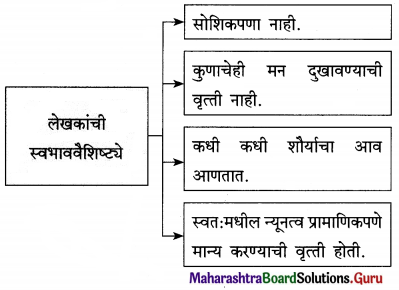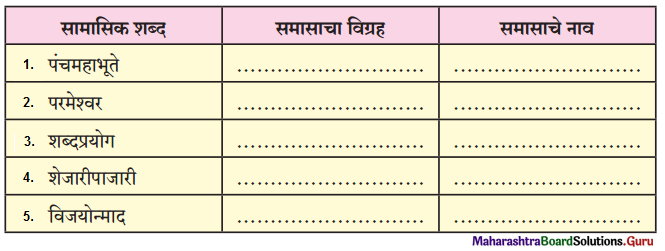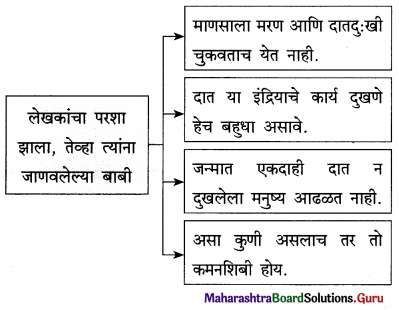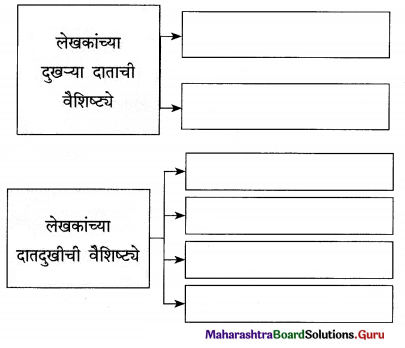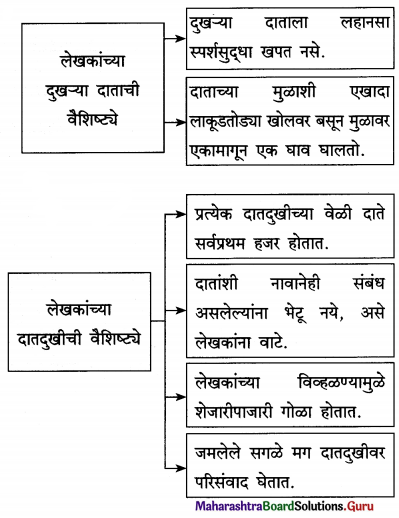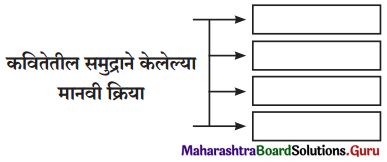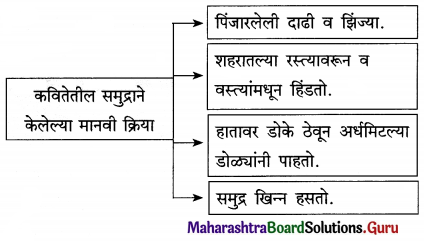12th Marathi Bhag 4.2 Exercise Question Answer Maharashtra Board
Balbharti Maharashtra State Board Marathi Yuvakbharati 12th Digest Bhag 4.2 माहितीपत्रक Notes, Textbook Exercise Important Questions and Answers.
माहितीपत्रक 12 वी मराठी स्वाध्याय प्रश्नांची उत्तरे
12th Marathi Guide Chapter 4.2 माहितीपत्रक Textbook Questions and Answers
कृती
1. माहितीपत्रक म्हणजे काय ते सोदाहरण सांगा.
उत्तर :
बदलत्या काळात उत्पादनांची संख्या दिवसेंदिवस वाढत आहे. संस्था/उत्पादन/सेवा यांमध्ये कमालीची स्पर्धा निर्माण झाली आहे. अशा वेळी ग्राहकांपर्यंत आपले उत्पादन पोहोचवण्यासाठी उत्पादकांकडून माहितीपत्रकाचा वापर वाढला आहे. माहितीपत्रक कुठल्याही संस्थेचा/उत्पादनाचा/सेवेचा वैशिष्ट्यपूर्णरीत्या परिचय करून देत असते. जनमत आकर्षित करण्यासाठी एकप्रकारचे लिखित स्वरूपाचे जाहीर आवाहन आहे. माहितीपत्रकामुळे उत्पादकाला नवीन बाजारपेठेत सहज प्रवेश करता येतो. कमी वेळात, कमी खर्चात विश्वासार्ह माहिती ग्राहकाकडे माहितीपत्रकाच्या माध्यमातून पोहोचवता येते. सामान्य भाजी विक्रेत्यापासून ते करोडोंची उलाढाल करणाऱ्या व्यापाऱ्यापर्यंत सर्वांना माहितीपत्रकाची आवश्यकता भासते.
पुस्तके, खेळणी, किराणामाल, दिवाळीअंक, फर्निचर, स्टेशनरी, घरगुती वापराची उपकरणे, वाहने, कारखाने, औषधे, विविध खादयपदार्थ, रेडीमेड साड्या अशा सर्वच बाजारात उपलब्ध होणाऱ्या वस्तूंची माहितीपत्रके पाहावयास मिळतात. यासोबतच सिनेमागृहे, सांस्कृतिक संस्था, शैक्षणिक संस्था, बँका, पतपेढ्या, पर्यटनसंस्था इत्यादींमध्येही समुदाय आकर्षित करण्यासाठी माहितीपत्रकाची आवश्यकता असते. तसेच, कला, संगीत, विविध अभ्यासक्रम, विविध बांधकामे, गृहसंकुल इत्यादी क्षेत्रांतही माहितीपत्रक महत्त्वाची भूमिका निभावत असते. ज्या ज्या क्षेत्रात लोकआकर्षणाची गरज असते तिथे माहितीपत्रक आवश्यक ठरते. माहितीपत्रक हे विशिष्ट संस्था/उत्पादन/सेवा यांचा चेहरा असते, असे म्हटल्यास वावगे ठरणार नाही.
![]()
2. माहितीपत्रकाची वैशिष्ट्ये खालील मुद्द्यांना धरून स्पष्ट करा.
(अ) आकर्षक मांडणी
उत्तर :
माहितीपत्रक हे उत्पादनाचे परिचयपत्रक असते. संस्था/ उत्पादन/सेवा यांची सविस्तर माहिती माहितीपत्रकातून मिळत असते. माहितीपत्रकातील छापील मजकूर जेवढा महत्त्वाचा असतो, तेवढीच त्या मजकुराची पानावरची मांडणीही महत्त्वाची असते. माहितीपत्रक दिसताच क्षणी ते ‘वाचावे’से वाटले पाहिजे. पानांवर मजकुराची ठेवण, कागदाचा आकार, रंगीत छपाई, अक्षरांचा आकार, सुलेखन, समर्पक चित्रे इत्यादी गोष्टींचा बारकाईने विचार माहितीपत्रकात करणे आवश्यक असते. माहितीपत्रकावरील शीर्षक, बोधचिन्ह, बोधवाक्य यांचे स्थान नेमके असावे. तंत्रज्ञानाच्या युगात रंगीत छपाई अधिक पसंत केली जात आहे. कागदाचा आकार मजकूर मांडणीला उठाव देण्यास साहाय्य करीत असतो. माहितीपत्रकातील अक्षरे ठळक दिसतील अशी असावीत. माहितीपत्रकाची मांडणी वेधक करण्यासाठी चित्रकार, कौशल्यपूर्ण कलाकार, संगणक तज्ज्ञ मदतीला असल्यास माहितीपत्रकाची मांडणी आकर्षक होण्यास दिशा मिळते.
(आ) भाषाशैली
उत्तर :
आपल्या उत्पादनाची सविस्तर व विश्वासार्ह माहिती ग्राहकांपर्यंत पोहोचवण्याचे माहितीपत्रक हे उत्तम साधन आहे. माहितीपत्रकाच्या दृश्यमांडणीत मजकुराला विशेष महत्त्व आहे. दर्शनी रूपासोबत माहितीपत्रकाच्या मजकुरालाही फार महत्त्व आहे. माहितीपत्रक वाचले जाण्यासाठी त्यातील भाषाशैली ग्राहकाला आकर्षित करणारी असावी. सोपी परंतु परिणामकारक असावी. माहितीपत्रकाची भाषा पाल्हाळीक नसावी. मनाची पकड घेणारी आणि आशय सहज ध्वनित करणारी असावी. माहितीपत्रकाची भाषा उत्पादनाची स्तुती करणारी असावी. परंतु ती अवास्तव असणार नाही याची काळजी घेणे आवश्यक ठरते.
उदा., ‘आमच्या घरगुती पोळीभाजी केंद्रात पोटभर जेवण मिळेल, घरच्या जेवणाचा अनुभव येईल, कमी किमतीत चवदार अन्न मिळेल.’ एवढ्या माहितीसाठी ‘पोटभर जेवण; घरच्या चवीचा स्वाद, किंमतही कमी, दयाल तुम्हीही दाद’ अशा एकाच वाक्यात सांगताना मनाला स्पर्श करणारी भाषाशैली माहितीपत्रकात असणे साहाय्यक ठरते. वाचकमनावर ठसा उमटवणारी भाषाशैली माहितीपत्रकात असणे आवश्यक असते.
3. थोडक्यात माहिती लिहा.
(अ) माहितीपत्रकाची गरज असणारी क्षेत्रे.
उत्तर :
आज स्पर्धेच्या युगात व्यापाराच्या बाबतीत उत्पादक आणि ग्राहक फार चौकस झाले आहेत. उत्पादकांना आपले उत्पादन/सेवा अधिकाधिक लोकांपर्यंत पोहोचवणे अगत्याचे असते; तर घरबसल्या सर्व उत्पादनांची सविस्तर माहिती मिळवणे हे ग्राहकांसाठी महत्त्वाचे असते. अशा वेळी ‘माहितीपत्रक’ या दोहोंत समन्वय साधत असते. आज असे कुठलेच क्षेत्र नाही जिथे माहितीपत्रकाची आवश्यकता नाही. फळे-भाजी विकणाऱ्या सर्वसाधारण विक्रेत्यापासून करोडोंचे आर्थिक व्यवहार करणाऱ्या संस्था, व्यापारी सर्वांनाच माहितीपत्रक आवश्यक असते. शैक्षणिक, सांस्कृतिक संस्था, विविध अभ्यासक्रम चालवणाऱ्या शैक्षणिक संस्था, प्रवासी कंपन्या, शेती अवजारे निर्माण करणाऱ्या कंपन्या, संगीत, कला यांसारख्या क्षेत्रांत माहितीपत्रक महत्त्वाचे ठरते.
उदा., एखादया शैक्षणिक संस्थेच्या नवीन अभ्यासक्रमाची माहिती विदयार्थी आणि पालकांपर्यंत पोहोचवण्यासाठी माहितीपत्रक गरजेचे असते. कारखाने, नाट्यगृहे, सिनेमागृहे, बँका, बचतगट, तसेच, औषधे, विद्युत उपकरणे, वाहने, वगैरेंची निर्मिती करणारे उदयोग, यांसारख्या क्षेत्रांतही माहितीपत्रक महत्त्वाचे असते. उदा., विद्युत उपकरणे खरेदी केल्यावर त्यांच्या जोडणीपासून उपयुक्ततेपर्यंत सर्व बाबी सविस्तर माहितीपत्रकात नमूद केलेल्या असतात.
![]()
(आ) माहितीपत्रक म्हणजे अप्रत्यक्षपणे जाहिरातच.
उत्तर :
माहितीपत्रक म्हणजे वैशिष्ट्यपूर्ण माहिती देणारे परिचयात्मक पत्रक होय. वेगवेगळ्या संस्था/कंपन्या आपले उत्पादन लोकांपर्यंत पोहोचवण्यासाठी माहितीपत्रके काढत असतात. माहितीपत्रकामुळे एकावेळी मोठ्या जनसमुदायापर्यंत सविस्तर माहिती पोहोचवता येते. कमी खर्चात, कमी वेळेत अधिकाधिक ग्राहकांपर्यंत पोहोचणे शक्य होते. माहितीपत्रकाचे नीटनेटके स्वरूप ग्राहकाला आकर्षित करीत असते. माहितीपत्रकात ‘माहिती’ला अधिक महत्त्व असते. त्यामुळे माहितीपत्रकाच्या हेतूशी सुसंगत माहिती ग्राहकांपर्यंत पोहोचवली जाते.
जनमत आकर्षित करण्यासाठी माहितीपत्रक म्हणजे पहिली पायरी असते. व्यापारी आणि ग्राहक यांच्यात सुसंवाद माहितीपत्रकाने साधला जातो. माहितीपत्रकामुळे उत्पादकाला नवीन बाजारपेठ उपलब्ध होण्यास मदत होते, तर ग्राहकाला उत्पादनाचा विश्वासार्ह आढावा घेता येतो. माहितीपत्रक उत्पादनाविषयी औत्सुक्य निर्माण करून ग्राहकाला आपलेसे करीत असते. त्यामुळे माहितीपत्रक म्हणजे अप्रत्यक्षपणे जाहिरात असते, असे म्हटल्यास अतिशयोक्ती वाटणार नाही.
4. माहितीपत्रकाची उपयुक्तता तुमच्या शब्दांत स्पष्ट करा.
उत्तर :
माहितीपत्रक वाचून झाल्यावरही लोकांनी ते जपून ठेवणे ही उत्तम माहितीपत्रकाची ओळख असते. माहितीपत्रक नवनवीन योजना/सेवा/उत्पादने यांची सविस्तर माहिती ग्राहकांना देत असते. फळफळावळ आणि भाजीपाला विक्रेते यांपासून करोडो रुपयांचा व्यवसाय करणाऱ्या व्यापाऱ्यांपर्यंत सर्वांना माहितीपत्रकाची आवश्यकता असते. पुस्तके, स्टेशनरी, किराणामाल, दिवाळीअंक, घरगुती वापराची उपकरणे, अलिशान गाड्या अशा सर्वच उत्पादनाची माहिती माहितीपत्रकातून मिळत असते. उत्पादनाच्या सोयी संदर्भातील शंकांचे निरसन माहितीपत्रक करीत असते. माहितीपत्रक योजना/सेवा/उत्पादन यांचा आरसा असते. माहितीपत्रकातील माहिती आकर्षक परंतु विश्वासार्ह असल्यास वाचक असे माहितीपत्रक जपून ठेवतात. त्याचा प्रचार करतात. उत्पादनाचे वैशिष्ट्य, वेगळेपण, ग्राहकाला होणारा फायदा या गोष्टी जिथे अधोरेखित करायच्या असतील, तिथे माहितीपत्रकाची भूमिका महत्त्वाची असते.
5. महाराष्ट्रीय पदधतीचे सुग्रास भोजन उपलब्ध करून देणाऱ्या भोजनगृहाचे माहितीपत्रक तयार करण्यासाठी कोणकोणते मुददे आवश्यक राहतील ते लिहा.
उत्तर :
- भोजनगृह चालवणाऱ्या संस्थेचे अथवा सदर भोजनगृहाचे नाव, बोधवाक्य, बोधचिन्ह.
- भोजनगृहाचा पत्ता/ स्थापना वर्ष/ नोंदणीक्रमांक/ दूरध्वनी/मोबाइल क्रमांक/ ई-मेल/ वेबसाईट इत्यादी.
- भोजनगृह चालवणाऱ्या व्यक्तीचे/सेवा देणाऱ्या व्यक्तीचे नाव/ संपर्क क्रमांक/ ई-मेल इत्यादी.
- भोजनगृहासंबंधी प्राथमिक माहिती. (महाराष्ट्रीयन पद्धतीचे सुग्रास जेवण, शाकाहारी आणि मांसाहारी जेवण, खादयपदार्थांचे वैशिष्ट्य.)
- भोजनगृहातील सुविधा. (बैठक व्यवस्था, बैठक संख्या, स्वच्छतागृह, लहान मुलांसाठी बगीचा, खेळणी इत्यादी.)
- भोजनगृहाची वैशिष्ट्ये. (शाकाहारी आणि मांसाहारी स्वतंत्र शेगडी; मालवणी, वैदर्भीय, मराठवाडी, खानदेशी, कोल्हापुरी, पुणेरी खादयपदार्थ यांचे वैविध्य.)
- भोजनगृहाची माहिती. (उदा., खादयपदार्थांची यादी, किंमत, भोजनगृहाची वेळ, सुट्टीचा दिवस, घरपोच सेवा.)
- भोजनगृहाची अन्य वैशिष्ट्ये. (विविध मसाले, लोणची, पापड, सांडगे, कोकम, आवळा सरबत इत्यादी पदार्थ विक्रीसाठी उपलब्ध.)
- भोजनगृहाची पूरक छायाचित्रे.
- भोजनगृहापर्यंत जाणाऱ्या रस्त्याची माहिती/जवळील नावाजलेले ठिकाण इत्यादी.
![]()
6. एका वस्त्रदालनाचे आकर्षक माहितीपत्रक तयार करा.
उत्तर :

माहितीपत्रक प्रस्तावना
आजचे युग हे स्पर्धेचे आहे. रोज नवनव्या संस्था, उदयोग उदयाला येत आहेत. नव्या तंत्रज्ञानाच्या सोबतीने नवनव्या योजना जागतिक बाजारात सर्रास वावरत आहेत. एखादया संस्थेची, योजनांची, उत्पादनाची तपशीलवार माहिती सर्वसामान्य लोकांपर्यंत पोहोचवण्याचे काम माहितीपत्रक करीत असते. जागतिकीकरण आणि व्यापारीकरणामुळे ग्राहकही दिवसेंदिवस जागरूक आणि चौकस होऊ लागला आहे. ग्राहकाला घरबसल्या लिखित स्वरूपात हे तपशील माहितीपत्रकाच्या माध्यमातून उत्पादक उपलब्ध करून देऊ लागले आहेत. माहितीपत्रक हे एकाअर्थी उत्पादनाचे, संस्थेचे प्रसिद्धीपत्रकच असते. माहितीपत्रकास उत्पादक आणि ग्राहक यांतील अप्रत्यक्ष दुवा म्हणता येऊ शकते.
![]()
माहितीपत्रकाचे स्वरूप :
- एखादी संस्था, उद्योग, गृहोदयोग यांत दिवसेंदिवस नवनवीन योजनांची भर पडत असते. जागतिकीकरणाच्या युगात नवनवीन संस्था, बँका, विविध सेवा पुरवणाऱ्या संस्था यांची निर्मिती व वाढ होत आहे.
- माहितीपत्रकातून विशिष्ट उत्पादन, सेवा यांची तपशीलवार माहिती मिळत असते.
- माहितीपत्रक म्हणजे वैशिष्ट्यपूर्ण माहिती देणारे लिखित स्वरूपातील परिचयात्मक पत्रक होय.
- माहितीपत्रक हे एक प्रकारे सेवा, संस्था लोकांपर्यंत पोहोचवण्याचे साधन आहे.
- माहितीपत्रकामुळे उत्पादक आणि ग्राहक यांच्यात संवाद निर्माण होतो.
- उत्पादनाला नवीन बाजारपेठ मिळवण्यासाठी माहितीपत्रक पहिली पायरी असते.
- माहितीपत्रक कमी वेळात, कमी खर्चात सविस्तर माहिती लोकांपर्यंत पोहोचवत असते.
- माहितीपत्रक उत्पादनाविषयी जनसामान्यांच्या मनात कुतूहल, उत्कंठा निर्माण करण्यात महत्त्वाची भूमिका बजावत असते.
माहितीपत्रकाची आवश्यकता :
- माहितीपत्रक म्हणजे सर्वसाधारणपणे प्रसिद्धीपत्रक असते.
- निरनिराळ्या संस्था, व्यापारी कंपन्या, उत्पादक आपल्या योजनांची तसेच उत्पादनांची माहिती लोकांपर्यंत पोहोचवण्यासाठी लिखित स्वरूपाच्या माहितीपत्रकांची निर्मिती करीत असतात.
- फळे, भाजीपाला विक्रेत्यांपासून ते लक्षावधींची उलाढाल करणाऱ्या व्यापाऱ्यांपर्यंत सर्वांना माहितीपत्रकाची आवश्यकता असते. उदा., पुस्तके, खेळणी, किराणामाल, दिवाळीअंक, फर्निचर, स्टेशनरी, घरगुती वापराची उपकरणे, वाहने, कारखाने, औषधे, विविध खादयपदार्थ, रेडीमेड साड्या अशा बाजारात उपलब्ध होणाऱ्या सर्वच वस्तूंची माहितीपत्रके पाहावयास मिळतात. यासोबतच सिनेमागृहे, सांस्कृतिक संस्था, बँका, शैक्षणिक संस्था, पतपेढ्या, पर्यटनसंस्था इत्यादींमध्येही समुदायाला आकर्षित करण्यासाठी माहितीपत्रकाची आवश्यकता असते.
- आपली वैशिष्ट्ये, वेगळेपण आणि ग्राहकाला होणारे फायदे अधोरेखित करण्यासाठी माहितीपत्रक उत्तम साधन असते.
![]()
माहितीपत्रकाचे वर्गीकरण :
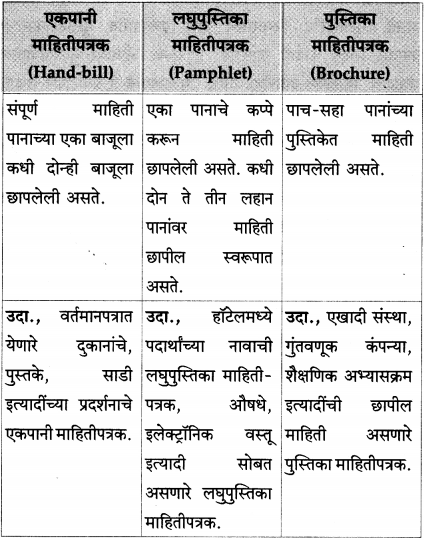
लक्षात घ्यावे असे :
बऱ्याचदा ‘माहितीपत्रक’ आणि ‘परिपत्रक’ यांतील भेद समजून घेण्यात चूक होऊ शकते. माहितीपत्रक आणि परिपत्रक यांत पुसटशी सीमारेषा आहे. माहितीपत्रक मोठ्या जनसमुदायासाठी असते, तर परिपत्रक शासकीय कर्मचाऱ्यांसाठी काढले जाते. परिपत्रकात कायदेशीर बाबींचा अवलंब केलेला असतो, माहितीपत्रकाचे स्वरूप मात्र सामान्यजनांना आकलन होण्याजोगे असते. माहितीपत्रकात विश्वासार्ह माहिती असणे अपेक्षित असते. माहितीपत्रक हे विशिष्ट संस्थेचा/ उत्पादनाचा/सेवेचा चेहरा असते.
माहितीपत्रकाची रचना :
1. ‘माहिती’ला प्राधान्य :
- माहितीपत्रकाच्या शीर्षकावरूनच त्याची प्रकृती लक्षात येते.
- माहितीपत्रकाचा ‘माहिती’ देणे हा मुख्य हेतू आहे.
- ज्या विषयाचे माहितीपत्रक आहे, त्याची सुसंगत, सविस्तर आणि अचूक माहिती त्यात असणे आवश्यक असते.
- संस्थेबद्दल विश्वासार्ह माहिती गरजेची असते. उदा., संस्थेचे कार्यालय, पत्ता, नोंदणीक्रमांक, बोधचिन्ह, संस्थेचे संचालक, अध्यक्ष यांचे संपर्क, ई-मेल, वेबसाईट इत्यादी माहिती अचूक असावी.
- माहितीपत्रकातील माहिती वस्तुनिष्ठ व सत्य असावी. अतिशयोक्ती तसेच चुकीची माहिती माहितीपत्रकात असू नये. माहितीपत्रकाची भाषा साधी, सोपी असावी. सामान्य लोकांना सहज आकलन होईल अशी भाषिकरचना असणे आवश्यक असते.
- माहितीचे स्वरूप सुटसुटीत असावे. माहितीचा अतिरेक असता कामा नये.
- परीक्षेत माहितीपत्रक तयार करताना त्यात चित्रे काढणे अपेक्षित नाही.
- फक्त भाषिक मजकूर पुरेसा असतो.
![]()
2. माहितीपत्रकाची उपयुक्तता :
- माहितीपत्रक हे उपयुक्त असावे. वाचून झाल्यावर चुरगळून फेकून न देता लोकांनी संग्रही ठेवावे अशा स्वरूपाचे असावे.
- माहितीपत्रकात ग्राहकाच्या उपयोगाची, जिव्हाळ्याची माहिती असल्यास माहितीपत्रकाची उपयुक्तता नक्कीच वाढते.
- माहितीपत्रकातील माहिती आकर्षक परंतु विश्वासार्ह असल्यास वाचक असे माहितीपत्रक जपून ठेवतात. त्याचा प्रचार करतात.
- माहितीपत्रकांची काही क्षेत्रे : ग्राहकाचे दैनंदिन प्रश्न, आरोग्य, शेती, तांत्रिक किंवा वैज्ञानिक स्वरूपाची माहिती देणारे माहितीपत्रक.
- ग्राहक अशा माहितीपत्रकांकडे लगेच वळतात. उदा., ‘कोरोनावर मात करताना अशी वाढवावी प्रतिकार शक्ती’, ‘फळांची खरी ओळख पटवताना…’, ‘कशी असते अन्नधान्यातील भेसळ?’
3. माहितीपत्रकाचे वेगळेपण :
- बाजारात रोज नवनवी उत्पादने येत असतात. या स्पर्धेत आपल्या उत्पादनाच्या माहितीपत्रकाचेही वेगळेपण टिकवणे आवश्यक असते. त्यासाठी माहितीची मांडणी वेगळेपणाने केली जाते.
- अन्य माहितीपत्रकांपेक्षा आपले माहितीपत्रक वेगळे ठरण्यासाठी मजकुराची आकर्षक मांडणी, माहितीची उपयुक्तता सांगणारा आकर्षक मजकूर, आकार, पानांची मांडणी, सुलेखन, अक्षरांची ठेवण इत्यादींद्वारे वेगळेपण आणले जाते.
4. आकर्षक मांडणी (ले-आऊट) :
- माहितीपत्रक दिसताक्षणी वाचावेसे वाटले पाहिजे. यासाठी माहितीपत्रकाची मांडणी आकर्षक असायला हवी.
- माहितीपत्रकाचा आकार योग्य असावा. खूप मोठा व लहान असता कामा नये.
- मध्यम आकारात माहितीच्या मजकुराची मांडणी नीटनेटकी करणे शक्य असते.
- माहितीपत्रकाचे पहिले पृष्ठ लक्षवेधी असावे. शीर्षक, बोधचिन्ह, बोधवाक्य ठसठशीत असावे.
- माहितीपत्रकाच्या कागदाची निवडही महत्त्वाची असते.
- कागद अगदी हलका तसेच अगदी जाड असणेही योग्य नाही.
- बदलत्या काळात रंगीत माहितीपत्रक ग्राहकाला आकर्षित करीत असतात. त्यांमुळे छपाई रंगीत असल्यास साहाय्य होते.
- माहितीपत्रकाची मांडणी दर्जेदार करण्यासाठी वेळोवेळी संगणक तज्ज्ञ, कुशल कलाकार, चित्रकार इत्यादींची मदत घेणे आवश्यक ठरते.
![]()
भाषाशैली :
- आपल्या उत्पादनाची सविस्तर व विश्वासार्ह माहिती ग्राहकांपर्यंत पोहोचवण्याचे माहितीपत्रक हे उत्तम साधन आहे. दर्शनी रूपासोबत माहितीपत्रकाच्या मजकुरालाही फार महत्त्व आहे.
- वाचकांना आकर्षित करण्यासाठी मजकुराची भाषा वेधक असणे आवश्यक आहे.
- माहितीपत्रकाची भाषा सोपी परंतु परिणामकारक असावी.
- माहितीपत्रकाची भाषा पाल्हाळीक नसावी. मनाची पकड घेणारी आणि आशय सहज ध्वनित करणारी असावी. उदा., गाण्याच्या नव्या वर्गांची माहिती देताना; ‘सूरांची बैठक पक्की केली जाईल, तज्ज्ञांचे मार्गदर्शन आणि गाण्याच्या सरावाकडे विशेष लक्ष दिले जाईल.’ एवढा आशय एका वाक्यातून सांगण्याऐवजी पुढील मुद्दयांत तो मांडता येईल :
ठळक वैशिष्ट्ये :
- सुरांची पक्की बैठक.
- तज्ज्ञांचे मार्गदर्शन.
- सरावावर खास भर.
व्यावसायिक संधी :
- आजच्या स्पर्धेच्या काळात आकर्षक आणि नेमकी माहिती पुरवणारे माहितीपत्रक तयार करणे ही व्यावसायिकांची गरज आहे आणि ती. वेळेवर उपलब्ध होणे ही ग्राहकांसाठी आवश्यक बाब आहे.
- आज बहुतांश माहितीपत्रके इंग्रजीतून निर्माण होत असल्याचे दिसते. अशा वेळी मराठीतून परिणामकारक माहितीपत्रके निर्माण करणाऱ्यांचे महत्त्व विशेष वाढताना दिसत आहे.
- तंत्रज्ञान, सौंदर्यदृष्टी आणि भाषेचे प्रभुत्व असणाऱ्या युवावर्गाला हे क्षेत्र खुणावत आहे.
- माहितीपत्रक तयार करणे या गोष्टीला व्यावसायिक मूल्य प्राप्त होत आहे.
- माहितीपत्रक संस्थेचा/उत्पादनाचा/सेवेचा चेहरा असल्याने माहितीपत्रकावरून संबंधित विषयाच्या कामाचा दर्जा लक्षात येत असतो. त्यामुळे व्यावसायिक दृष्टीतून दर्जेदार माहितीपत्रक निर्मात्याला प्रतिष्ठा आणि पैसा मिळू लागला आहे.
नोंद : माहितीपत्रकासाठी आवश्यक मुद्दे समजून घेण्यासाठी पाठ्यपुस्तक पृष्ठ क्र. ९६ वर दिलेला माहितीपत्रकासाठी आवश्यक मुद्द्यांचा नमुना अभ्यासा. तसेच अधिक अभ्यासासाठी पुढील नमुनाही अभ्यासा.
माहितीपत्रकासाठी आवश्यक मुद्द्यांचा नमुना :
महाविद्यालयीन विद्यार्थ्यांसाठी सुलेखनाचे वर्ग नव्याने सुरू करायचे आहेत. अधिकाधिक विद्यार्थी आणि पालकांपर्यंत ही माहिती पोहोचवायची आहे. त्यासाठी –
- ज्या संस्थेमार्फत सुलेखनाचे वर्ग चालवले जाणार आहेत त्या संस्थेचे बोधचिन्ह/बोधवाक्य, तसेच संस्थेच्या महत्त्वाच्या पदाधिकाऱ्यांची नावे, पदनाम.
- संस्थेचे नाव/पत्ता/स्थापना वर्ष/नोंदणीक्रमांक/दूरध्वनी/मोबाइल क्रमांक/ई-मेल/वेबसाईट इत्यादी.
- संस्थेची थोडक्यात माहिती. (संस्थेची स्थापना, स्थापनेचा हेतू, संस्थापक, अन्य उपक्रम इत्यादी.)
- सुलेखन वर्गाविषयी सविस्तर माहिती. (वर्ग सुरू करण्यामागचा हेतू, वयोगट, कालावधी इत्यादी.)
- सुलेखन वर्गासाठी असणाऱ्या सुविधा. (पेन, पेन्सिल, कागद, शाई इत्यादी साधनांची उपलब्धी, आवश्यक पुस्तके.)
- सुलेखन वर्गाची वैशिष्ट्ये. (मर्यादित विदयार्थी संख्या, वैयक्तिक मार्गदर्शन, तज्ज्ञ मार्गदर्शक, सुलेखनाचे प्रदर्शन, सुलेखनाची संधी इत्यादी.)
- सुलेखन वर्गाचे भविष्यातील महत्त्व.

- आधीच्या सुलेखन वर्गाची पूरक छायाचित्रे. (निवडक माजी विदयार्थ्यांच्या सुलेखनाची छायाचित्रे.)
- सुलेखन वर्गाच्या इमारतीपर्यंत जाणाऱ्या रस्त्यांची माहिती.
- प्रवेश प्रक्रिया, प्रवेशासाठी आवश्यक कागदपत्रे, शैक्षणिक पात्रता, फी स्वरूप, फी भरण्याचे टप्पे, सुलेखन वर्गाचा एकूण कालावधी, वेळ, सुट्ट्यांचे नियोजन, संबंधित अधिकाऱ्याचे नाव, संपर्क क्रमांक, सुलेखन वर्ग सुरू होण्याची तारीख इत्यादी.
नोंद : माहितीपत्रक समजून घेण्यासाठी पाठ्यपुस्तक पृष्ठ क्र.९८ व ९९ वर दिलेला माहितीपत्रकाचा नमुना अभ्यासा. तसेच अधिक अभ्यासासाठी पुढे दिलेला माहितीपत्रकाचा नमुनाही अभ्यासा.
माहितीपत्रकाचा नमुना
दर्शनी पृष्ठ :
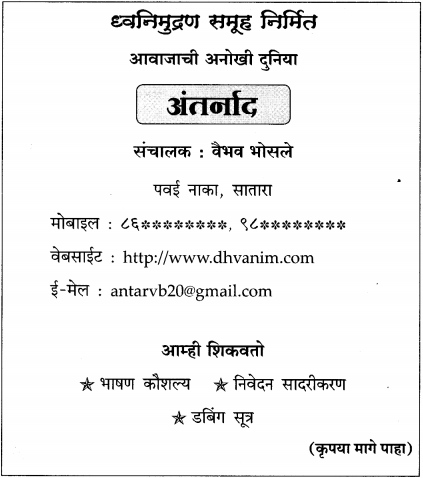
![]()
मागील पृष्ठ :

Class 12 Marathi Yuvabharati Textbook Solutions
- कथा-साहित्यप्रकार-परिचय Class 12 Marathi Textbook Solutions
- शोध Class 12 Marathi Textbook Solutions
- गढी Class 12 Marathi Textbook Solutions
- मुलाखत Class 12 Marathi Textbook Solutions
- माहितीपत्रक Class 12 Marathi Textbook Solutions
- अहवाल Class 12 Marathi Textbook Solutions
- वृत्तलेख (फिचर रायटिंग) Class 12 Marathi Textbook Solutions

